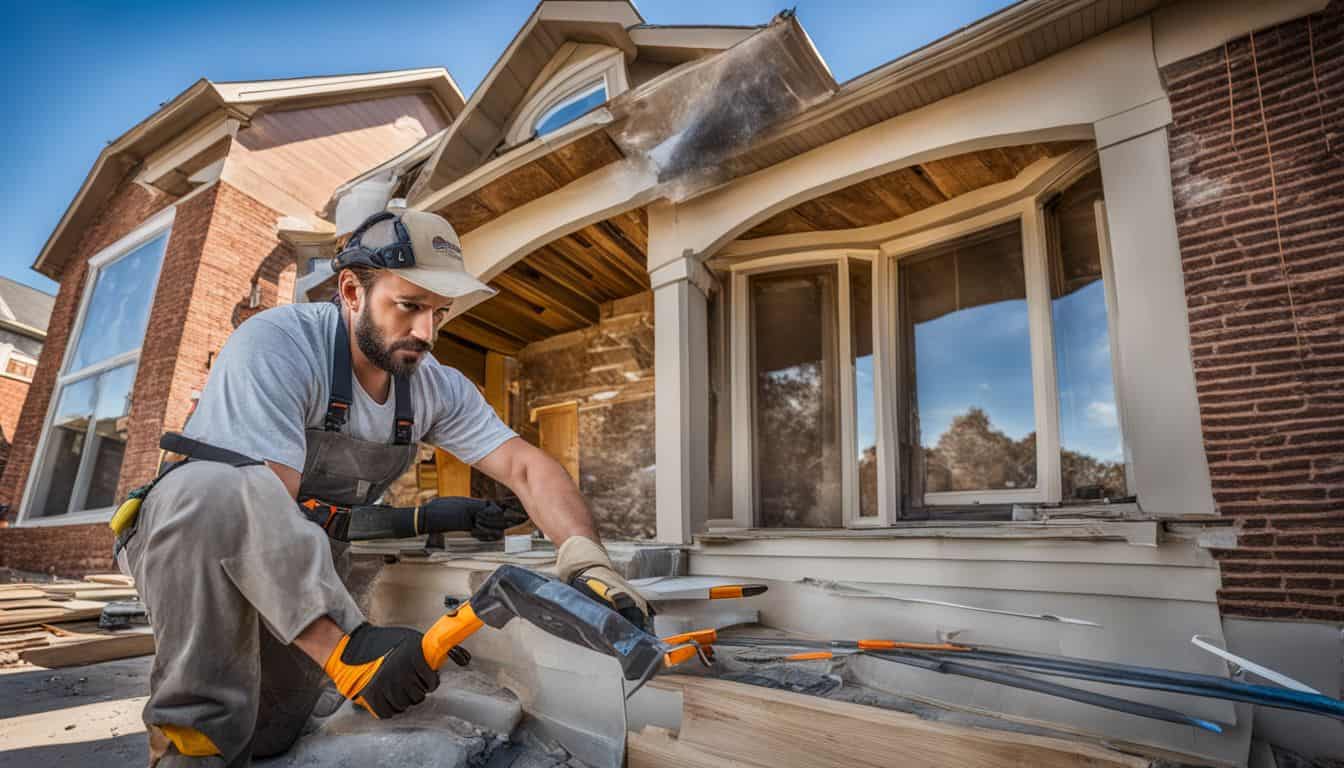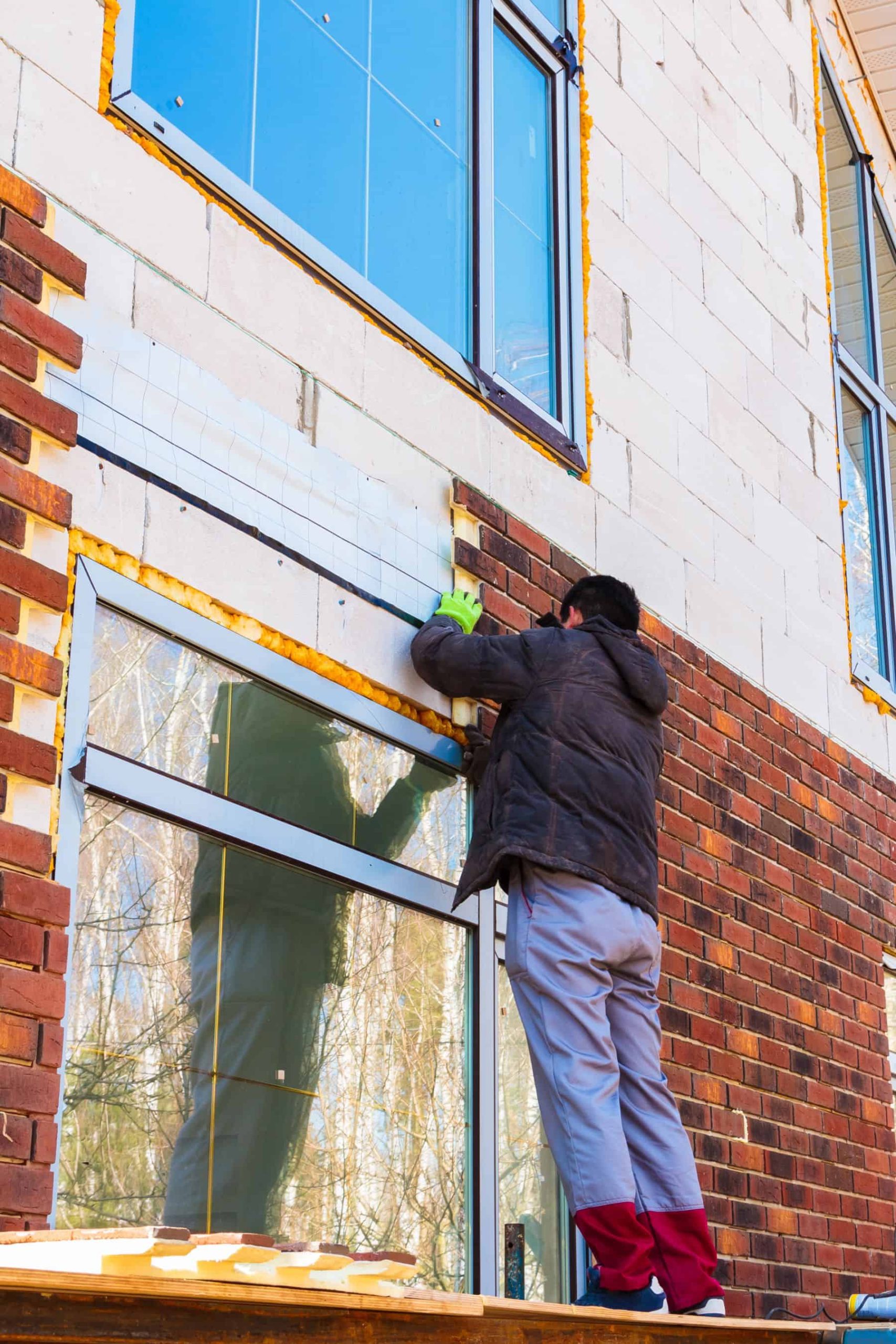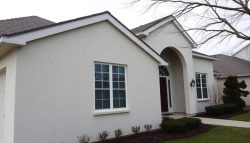Master the Art of Protecting Your EIFS from Water Damage: Expert Tips for Detection and Restoration
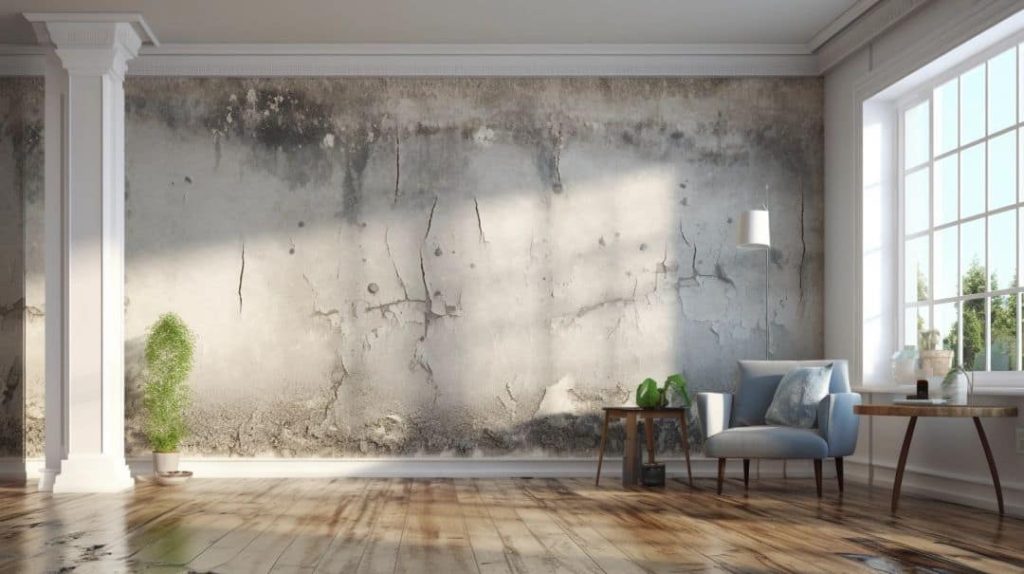
Water damage in your home’s Exterior Insulation and Finish Systems (EIFS) can be a silent but destructive force, sneaking up on even the most astute homeowners. As an industry professional with years of experience repairing and preventing EIFS-related issues, I’ve seen firsthand how quickly water infiltration can compromise the structural integrity of a building.
EIFS, often referred to as synthetic stucco, is designed for energy efficiency and aesthetic appeal; however, without proper attention to detail during installation and maintenance, water damage can become a persistent problem.
Understanding the critical importance of maintaining a watertight building envelope is your first line of defense against costly damage down the road. EIFS should stand at least six inches above finish grade to thwart any ground contact that could spell disaster for your cladding system—an essential fact not all installers heed.
With this guide, you’ll gain insider knowledge on safeguarding your investment before problems arise or efficiently addressing them if they do. Continue reading for strategies tailored just for you.
Key Takeaways
- EIFS is an insulating and aesthetic cladding system for homes that can suffer from water damage if not properly installed or maintained.
- Look out for signs of water damage such as soft spots, color changes, cracking, swelling, and condensation around your home’s exterior to catch issues early.
- Preventing EIFS water damage involves ensuring a proper installation with high-quality materials and regular maintenance including inspections and repair of cracks or gaps.
- Water often infiltrates at vulnerable points like window and door frames, roof flashings, utility penetrations, foundation junctions, joints, external corners, and high-condensation areas.
What is EIFS and What is Water Infiltration Damage?
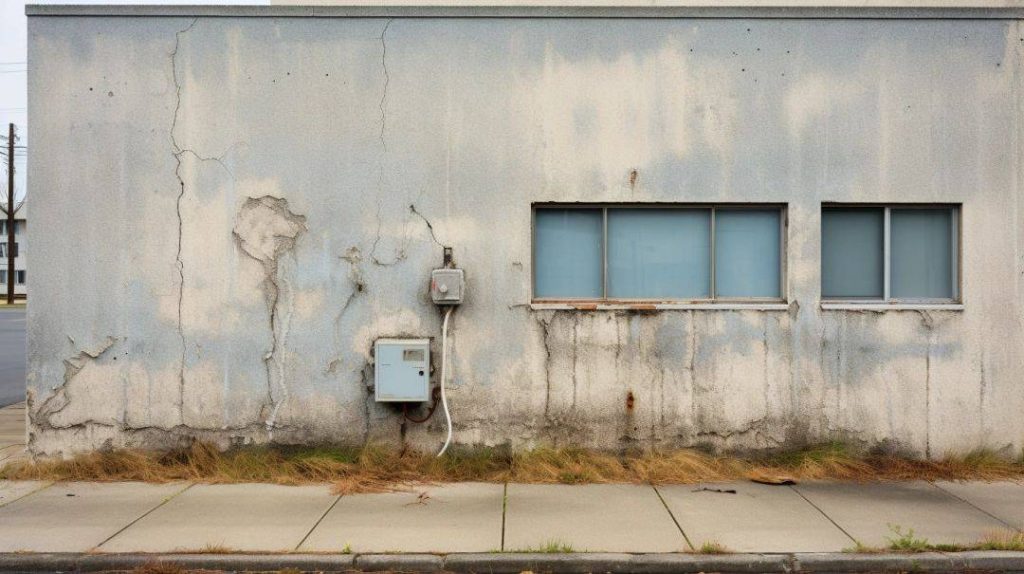
EIFS, or Exterior Insulation and Finish System, is like a protective skin for your home; it’s a layered installation that insulates while also giving your house a polished look. However, this cladding can betray you if water sneaks in – known as water infiltration damage – leading to problems ranging from unsightly stains to serious structural issues caused by moisture getting where it shouldn’t.
Definition of EIFS
EIFS stands for Exterior Insulation and Finish System, a layered exterior wall cladding. It includes an insulating board, typically made of polystyrene or similar materials, attached to the wall sheathing followed by a base coat reinforced with fiberglass mesh then finished with a durable topcoat.
This system offers excellent thermal insulation and is highly effective in conserving energy within your home.
Your house benefits from EIFS through its water-resistant nature and added insulation value that keeps the cold out and reduces heating costs. However, it’s crucial to ensure the proper installation of flashings and sealants around windows, doors, and roof lines to protect against potential water damage.
Moving on to common causes of such damage can help you stay vigilant about EIFS maintenance needs.
Common causes of water damage
Understanding the common causes of water damage in your EIFS system is crucial for maintaining its integrity. Here’s a breakdown of factors that can put your home at risk.
- Improper Installation: A primary culprit for water infiltration is improper installation, where sealants or flashing might be incorrectly applied, leaving gaps and weak points.
- Construction Defects: Faulty design or construction can lead to areas that collect water, creating an environment where moisture can penetrate and damage the EIFS.
- Failed Sealants: Over time, caulking joints may dry out or crack, which compromises the seal and allows water to enter behind the EIFS membrane.
- Roof and Flashing Issues: Improperly installed roof flashing fails to divert water effectively, leading to accumulation and potential seepage into the EIFS system.
- Mechanical Damage: Physical impacts, punctures, or heavy wear on the EIFS surface can create entryways for water.
- Thermal Bridging: When parts of the building form a conductive path for heat flow, condensation may build up at these points within the EIFS, contributing to moisture problems.
Signs of EIFS Problems

As you keep a watchful eye on your home’s exterior, be aware of key indicators that suggest trouble with your EIFS system. Water intrusion may manifest through visible cracks or swelling in the finish, while condensation inside can hint at deeper issues lurking beneath the surface.
If these signs are ignored, minor issues can quickly escalate into significant damage to your property’s structure and aesthetics.
Water intrusion
Water intrusion is a common issue for EIFS systems, but you can spot it before it causes major damage. Check your walls for soft spots or changes in color—these could be telltale signs of unwanted moisture seeping into your exterior insulation finishing system.
If the polystyrene board feels spongy or the paint appears discolored, these are red flags that water has breached your defenses.
Take action to prevent further destruction caused by penetrating water. Ensure there’s a proper gap between EIFS and the ground; this space helps keep the bottom edge dry and safe from splash-back wetness.
Detecting early signs like delaminating layers or swollen wood framing gives you an advantage in stopping water damage before it compromises your home’s structural integrity and aesthetic appeal.
Condensation
Shifting focus from water intrusion, condensation also plays a role in compromising your EIFS system. This sneakier form of moisture buildup can stem from temperature differences between the interior and exterior surfaces, leading to water collecting where you least expect it.
You’ll notice that during colder months or when air conditioning is running, condensation is more likely to occur. If left unchecked, this dampness can seep into your walls causing extensive damage over time.
You must actively check for signs of condensation, such as peeling paint or a musty smell indicating trapped moisture inside wall cavities. Unlike direct leaks, condensation-related problems may not be visible right away but still have severe implications for your EIFS’s integrity and performance.
Keeping an eye out for these subtle cues helps maintain a water-tight barrier against both obvious infiltrations and hidden humidity issues within your home.
Likelihood of EIFS Water Damage
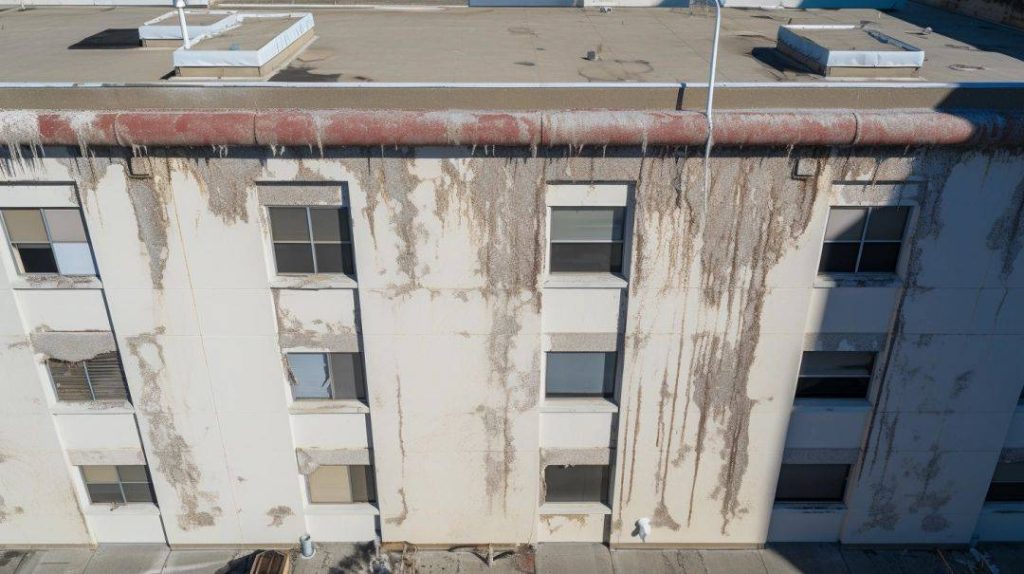
Understanding the likelihood of EIFS water damage requires recognizing the various factors that elevate risk. These include climatic conditions, building orientation, the quality of initial installation, and existing defects in the system.
Areas prone to heavy rainfall or extreme humidity are particularly susceptible to water infiltration issues. Additionally, EIFS systems installed without proper flashing and sealant details can quickly become victims of moisture intrusion.
Regular inspections play a crucial role in identifying potential problem areas such as rooflines, windowsills, and other penetrations where water damage is most common before they escalate into more significant concerns.
Factors that increase the chances of water damage
EIFS systems require vigilant maintenance to prevent water damage. Incorrect installation or neglect can significantly raise the risk of moisture issues within your home’s exterior.
- Improper Installation: If your EIFS was not properly installed, water resistance is compromised from the start. This can lead to gaps and areas where moisture easily seeps in.
- Lack of Maintenance: Ignoring regular check-ups and repairs on your EIFS can invite trouble. Small problems like cracks or holes become gateways for water if left untreated.
- Insufficient Sealing around Openings: Windows, doors, and other openings need to be sealed tightly. Weak sealing allows water to penetrate the EIFS barrier.
- Age and Wear: Over time, EIFS materials can degrade, especially if exposed to harsh weather conditions without adequate protective coatings such as paint or primer.
- Low-Quality Materials: Opting for cheaper building materials might save money initially but can reduce water resistance, leading to costly damage down the line.
- Landscaping Issues: Plants and irrigation systems too close to the structure cause persistent dampness on the EIFS surface which accelerates wear and promotes water entry.
- Improper Flashing Installation: Flashings divert water away from vulnerable areas of your home. Missing or faulty flashings mean that water may not be guided away effectively.
Areas where water damage is most common
Water damage in exterior insulation and finishing systems (EIFS) often occurs where you least expect it. Paying attention to the more vulnerable areas can save you time and money on repairs.
- Window and Door Frames: Water tends to collect around window sills and door thresholds. Improperly sealed frames allow moisture to seep behind the EIFS, leading to potential soft wood damage underneath.
- Roof Flashings: The intersection of the roof and EIFS wall is particularly susceptible. Faulty or aged flashing fails to redirect water away, causing accumulation and subsequent water infiltration.
- Penetrations for Utilities: Openings made for electrical, plumbing, or HVAC systems can be entry points for water if not properly sealed with a washer or high-quality sealant.
- Foundation Junctions: Moisture issues are common where EIFS meets the foundation. If EIFS is too close to the ground—closer than recommended—it can wick up moisture, leading to deterioration.
- Joints and Sealants: Over time, expansion and shrinkage cause joints and sealants to wear. Cracks or gaps in these areas invite water into the system.
- Exterior Corners: These high-stress areas are prone to develop cracks that compromise EIFS integrity. Regular checks are necessary to prevent water ingress through tiny fissures.
- Areas with High Condensation Potential: Places prone to condensing moisture like bathroom exteriors need vigilant monitoring as they can saturate adjacent EIFS walls over time.
How to Prevent Water Damage in EIFS Systems
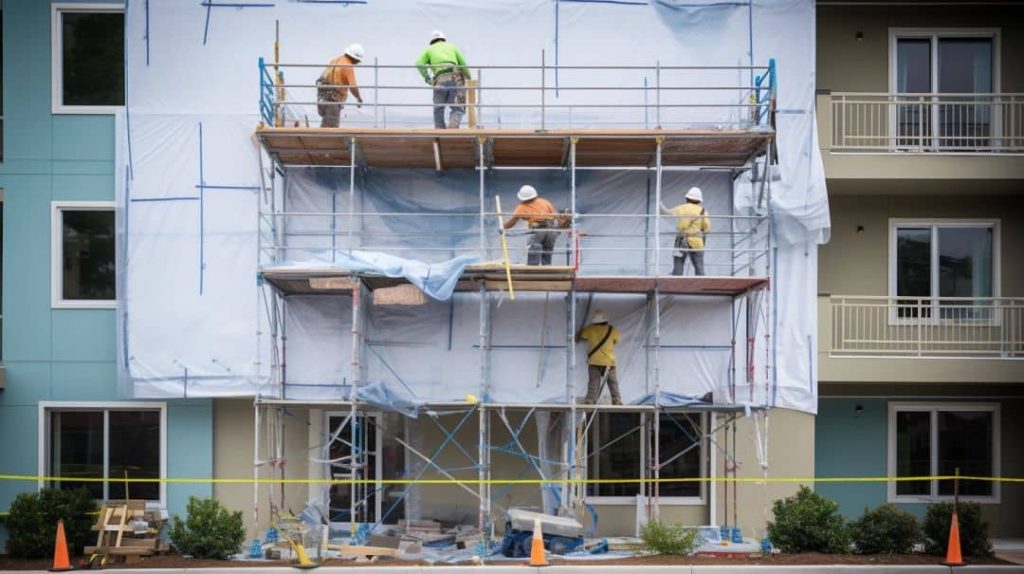
To shield your EIFS system from water damage, meticulous installation is non-negotiable, alongside a regimen of routine maintenance that includes diligent inspections and the strategic application of quality sealants.
This proactive approach not only preserves the integrity of your home’s exterior but also forestalls costly repairs down the line.
Proper installation techniques
Proper installation techniques for EIFS are crucial to preventing water damage. Always start by ensuring that the base of the EIF system sits a minimum recommended height above finish grade, as this distance helps shield the material from moisture and ground contact.
Use high-quality materials, including durable acrylic or polymer-based coatings that resist cracking and properly bond with the insulation. Installers must pay special attention to wrapping windows and doors correctly with flashing to prevent any water seepage, which is often a vulnerable point in these systems.
Moreover, it’s essential to apply each layer of EIFS as specified by manufacturers: affix foam insulation boards tightly together without gaps; use the right type and amount of adhesive; embed mesh into the base coat fully for reinforcement before adding finishes.
Skilled professionals should ensure all edges around penetrations like vents or pipes are sealed with sealant appropriate for EIFS applications—DOWSIL™ sealant is an excellent choice here—to avoid entry points for water.
This painstakingly detailed process can be your best defense against costly future repairs due to water infiltration in your exterior insulation finishing systems.
Regular maintenance
Keep your EIFS system in top shape with regular maintenance. Check the exterior for any areas that feel soft or look discolored – these could be warning signs of underlying water damage.
Make sure to inspect around windows, doors, and other openings where sealants and flashing are essential for keeping moisture out. It’s crucial to ensure there is sufficient clearance between the bottom of your EIFS cladding and the ground; this will help prevent water from splashing up and causing damage.
Staying vigilant about maintenance not only preserves the appearance of your home but also protects it structurally. Look closely at finish coatings for signs of flaking or looseness that might suggest a compromised barrier against moisture intrusion.
Addressing these issues promptly can save you from costly repairs down the line.
After discussing regular maintenance, let’s explore how to properly use sealants as another defense against water infiltration in your EIFS systems.
Proper use of sealants
Using sealants correctly is a vital step in protecting your EIFS against water damage. You’ll want to select high-quality sealant products that are designed for use with exterior insulation and finish systems.
Apply them meticulously around windows, doors, and other areas where materials meet or there’s potential for moisture ingress. It’s essential to ensure the sealant smoothly bridges gaps without any bubbles or voids that could let water sneak through.
Ensure you regularly inspect and replace worn-out or damaged sealants as part of your maintenance routine. This proactive approach helps maintain the integrity of the EIFS by preventing water from penetrating vulnerable junctions.
Up next, we’ll dive into how to identify signs of water damage within your EIFS system.
Identifying Water Damage in EIFS Systems
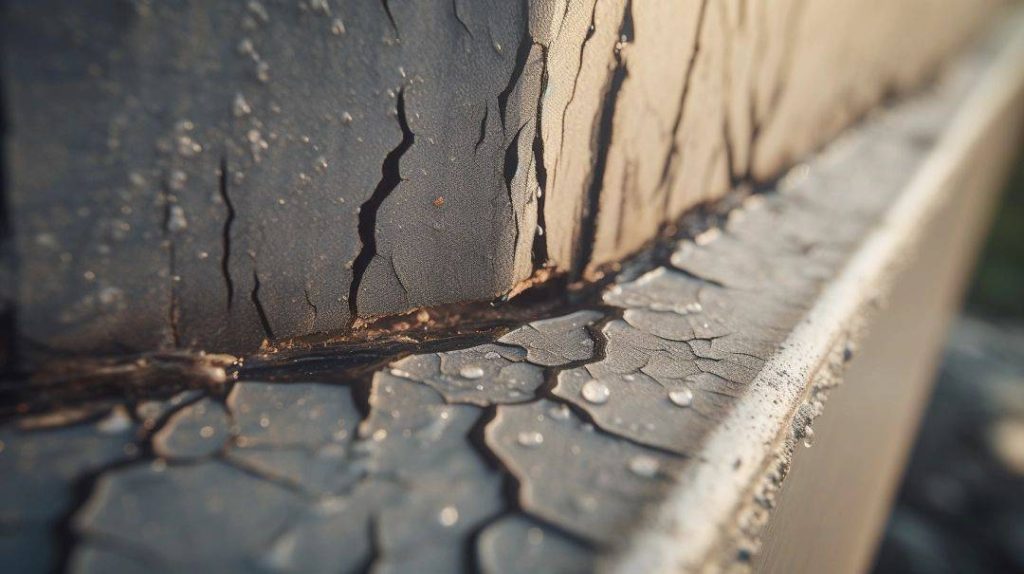
To pinpoint water damage in your EIFS, keep an eye out for tell-tale signs such as swelling or soft spots in the wall material, discoloration akin to stains from leakage, and peeling paint—an indicator that moisture might be breaching your system.
To uncover less obvious damage, a thorough inspection by using moisture meters or infrared cameras can reveal hidden issues within the EIFS layers before they escalate into major problems.
Visual signs of water damage
Knowing the visual signs of EIFS water damage is critical for maintaining your home’s exterior. Act swiftly if you notice any of these indicators to protect the integrity of your building.
- Cracking or splitting in the finish: Small cracks may seem insignificant, but they can allow water to seep into your EIFS system.
- Bubbling or blistering surfaces: These typically occur when water has become trapped beneath the outer layer, signaling that repair is needed.
- Discolored patches: Stains or changes in color often point to prolonged moisture presence and potential damage within.
- Soft spots on the wall: Areas that feel spongy compared to their surroundings suggest underlying issues with water infiltration.
- Peeling paint: Paints used over EIFS systems should adhere well unless compromised by moisture.
- Mold or mildew presence: Mold growth on the surface indicates high moisture levels, a problem needing immediate attention.
- Swelling around windows and doors: This usually means water has penetrated these vulnerable areas and may be causing hidden damage.
Detecting hidden water damage
While visible signs of water damage in EIFS are evident to the eye, hidden problems can be trickier to uncover. Homeowners should conduct thorough inspections regularly to catch these inconspicuous issues early.
- Use a moisture meter: A reliable way to detect hidden water damage is by using a moisture meter on your EIFS system. Probe different areas, especially where water may collect, and monitor the readings for any abnormal moisture levels.
- Inspect around windows and doors: Check the sealant around all windows and doors, as gaps or cracks can allow water to seep behind the EIFS.
- Look for mold or mildew presence: Often, if there’s hidden water damage within your EIFS system, you’ll find mold or mildew growth in areas like basements or lower-level walls.
- Tap on the surface: Gently tap on areas of your EIFS; hollow sounds could suggest underlying water damage damaging the attachment of the EIFS to its substrate.
- Observe any buckling or warping: If parts of your EIFS appear uneven or misshapen, this could indicate that moisture has compromised the integrity of the system’s structure.
- Examine interior walls: Sometimes, signs of internal water damage materialize inside. Watch out for peeling paint or wallpaper, discoloration, and swelling in drywall as indicators of potential issues with exterior insulation systems.
- Investigate suspicious odors: Musty smells often accompany hidden dampness within walls—don’t ignore persistent earthy or stale odors in your home.
- Pay attention to rusting metal components: Visible rust on metal fasteners and lath could point towards unwelcome moisture having infiltrated your EIFS.
Repairing Water-Damaged EIFS Without Complete Removal
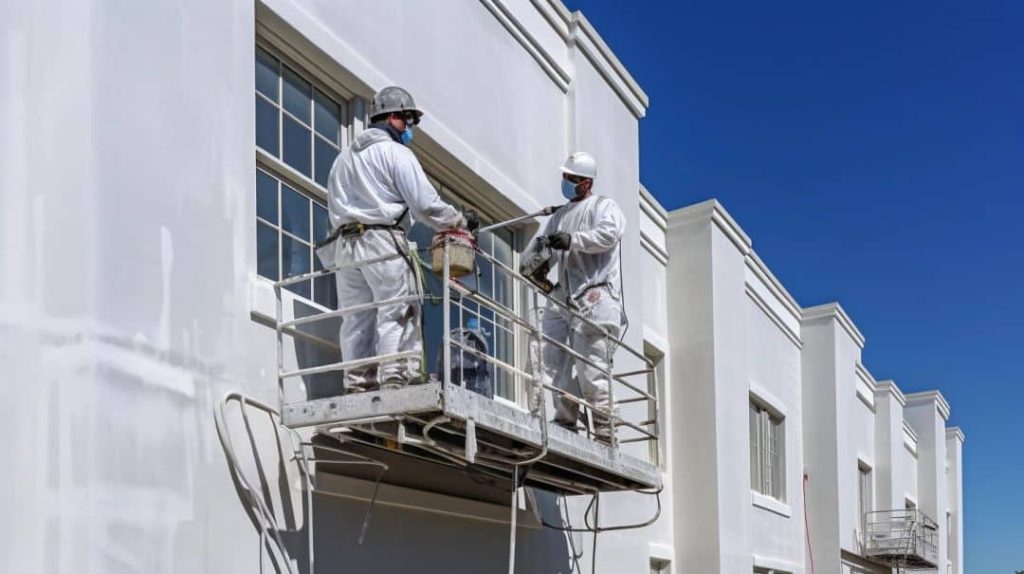
If you discover water damage in your EIFS, complete removal isn’t always necessary. It’s critical to assess the extent of the damage promptly. Small areas affected by moisture can often be repaired with targeted fixes that restore integrity without dismantling the entire system.
This approach is not only cost-effective but also less disruptive to your day-to-day life. The key lies in identifying problem spots early and addressing them before more substantial harm occurs; this way, you preserve both your home’s exterior and your wallet.
Determining the extent of damage
To determine the extent of damage, you’ll want to check for areas that seem soft or show discoloration. These are telltale signs that water has compromised your EIFS system. Inspect for flaking or a loose finish, which can indicate underlying issues needing immediate attention.
You must remove any damaged sections of EIFS materials and substrate carefully to assess the impact on the EPS board underneath.
After assessing visibly affected areas, look for hidden damage by feeling for uneven surfaces or examining where mold might have taken hold due to moisture penetration. This step is critical before applying new base coats and reinforcing mesh as part of your repair process.
Once you’ve evaluated all damaged components, consider high-quality solutions like DOWSIL™ sealant to ensure repairs last and protect against future water infiltration.
Moving forward from determining the damage, understanding cost-effective repair options will help maintain your home’s integrity without breaking the bank.
Cost-effective repair options
Repairing water damage in your EIFS doesn’t have to break the bank. Explore these budget-friendly strategies to restore your home’s exterior efficiently.
- Inspect the damaged area carefully to assess the extent of water penetration and the condition of the underlying EPS board. If the board is salvageable, this can save on material costs.
- Remove only the compromised sections of EIFS, rather than taking down large expanses that might still be in good shape. This targeted approach helps minimize waste and labor expenses.
- Dry out any water-soaked areas thoroughly before proceeding with repairs, as trapping moisture can lead to further damage and mold issues.
- Use high-quality but reasonably priced sealants like DOWSIL™ for resealing joints and penetrations, ensuring a watertight seal without overspending on products.
- Consider using reinforcing mesh within the base coat over affected areas for added strength and longevity; it’s an additional step that can prevent future repairs.
- For homes with face-sealed perfect barrier EIFS systems recognized as flawed, opt for localized repairs if the rest of the system is still functional rather than a full-system replacement.
- Partner with experienced professionals who provide quality service at competitive rates. Their expertise means repairs are done right the first time, saving money in the long run.
Cases for Complete Removal of EIFS
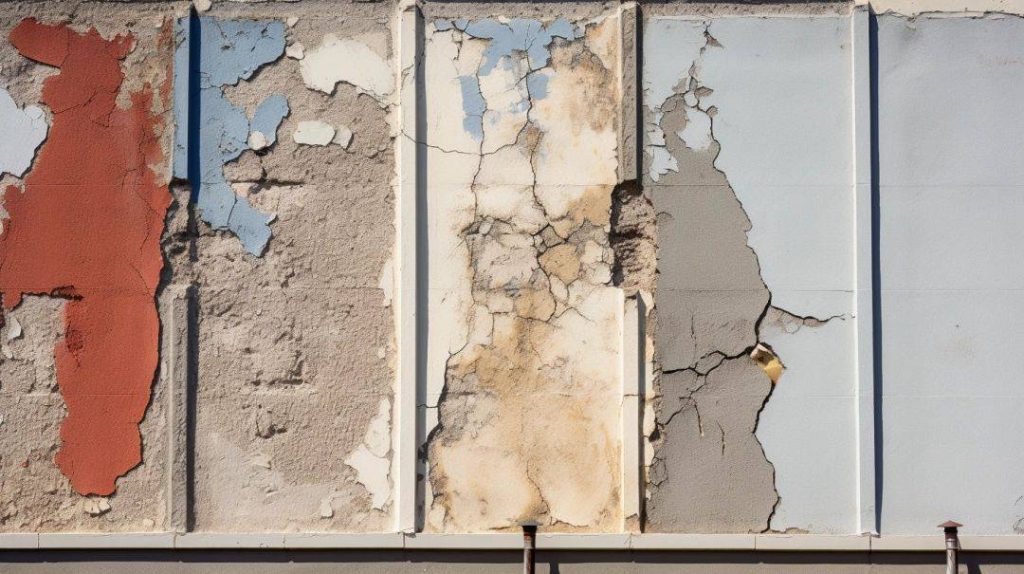
When dealing with EIFS, there are scenarios where patch repair won’t suffice and complete removal becomes essential. This step is often taken when water damage has severely compromised the integrity of the system, leading to widespread mold growth or posing safety hazards to occupants.
The decision for a full-scale removal should be based on a thorough assessment by a qualified professional who can identify if the underlying structure has been irreversibly damaged or if health risks from mold and mildew are present.
Severe water damage
Severe water damage in EIFS systems signals a major red flag for homeowners. It typically means that moisture has breached the exterior insulation and finish system, potentially affecting the structural integrity of your home.
This level of damage often presents as soft spots on walls or areas where the finish is severely discolored. Immediate action is necessary to prevent further deterioration, which may include removing compromised EIFS material down to the substrate.
Repairing this kind of extensive water damage goes beyond simple fixes—it’s crucial to address not only the visible issues but also underlying problems like damaged EPS boards. Reapplying base coats with reinforcing mesh and using new sealants become part of a rigorous repair process aimed at restoring your EIFS system’s protective capabilities.
Don’t wait until it’s too late; tackle severe water damage head-on with expert help to safeguard your home from any future risks associated with faulty EIFS installations.
Mold growth
Mold growth in EIFS is a silent predator that can undermine the structural integrity of your home and pose health risks. It thrives in moisture-rich environments, often a consequence of water infiltration within the exterior insulation finishing systems.
Keep an eye out for discoloration or musty odors, as these are telltale signs that mold may be present. If you detect any soft spots on your walls or see visible mold patches, take prompt action to address the issue.
Tackling mold involves removing affected EIFS materials carefully and repairing underlying EPS boards where needed. Applying new DOWSIL™ sealants helps reinstate a formidable defense against future moisture invasion, ensuring your EIF system continues to insulate and protect efficiently.
Remember, professional help from experts like Ai Restoration is key to ensuring safe and thorough removal of all contaminated material, leaving no room for recurrence and guaranteeing peace of mind.
Safety concerns
Beyond the unsightly appearance and structural issues, mold growth points to a far more critical aspect of your EIFS system’s health: safety. Water damage can severely compromise the integrity of exterior walls, putting you and your family at risk.
It’s not just about aesthetics or property value; it’s about ensuring that everyone inside is protected from potential harm.
If parts of the EIFS are soft to touch or show signs of discoloration, these may be red flags for underlying problems that need immediate attention. Acting swiftly can prevent minor water intrusion from escalating into major safety hazards such as wall collapses or compromised electrical systems.
The strength and durability of your home depend on vigilant maintenance and timely repairs so never overlook any sign that suggests possible water damage within an EIF system.
Hiring a Professional for EIFS Water Damage Repair
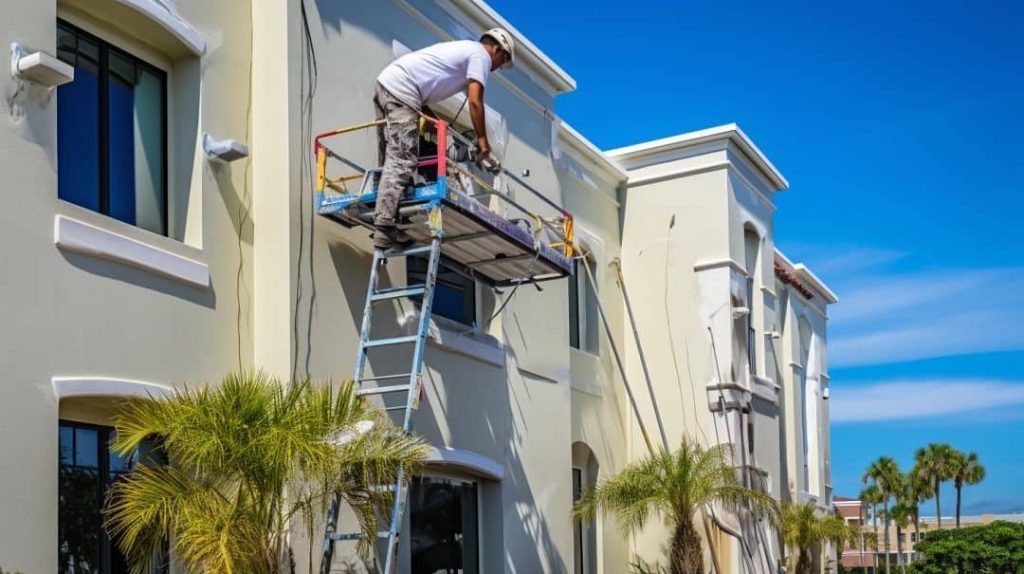
Selecting the right professional is pivotal for effective EIFS water damage repair; their expertise will address complex issues and ensure durability. Read on to grasp the importance of expertly-handled repairs.
Importance of experience and expertise
Hiring a professional with the right experience and expertise is crucial for repairing EIFS water damage effectively. These skilled experts bring a depth of knowledge about exterior insulation finishing systems that can’t be matched by general contractors or DIY attempts.
They understand the nuances of working with EIFS, from choosing the correct sealants to assessing hidden damages behind those painted outer layers. Their hands-on experience means they can pinpoint problems quickly and devise solutions that go beyond surface-level fixes.
Expertise in EIFS repair involves more than just fixing what’s visible; it’s about ensuring your home’s integrity for years to come. Professionals are adept at identifying all signs of trouble, such as flaking finish or discolored sheathings that suggest underlying issues.
They employ industry-best practices like replacing damaged EPS boards and reinforcing them with fresh base coats and mesh, preventing future complications. Trusting this task to someone who has navigated countless EIFS repairs translates into peace of mind that your home is in capable hands.
Choosing the right contractor
Selecting the appropriate contractor for EIFS water damage repair is crucial. You need someone with the right expertise and experience to ensure your home’s exterior is restored properly.
- Look for a contractor with specific experience in exterior insulation and finish systems. Their familiarity with EIFS will be vital for proper diagnosis and repair.
- Ask potential contractors about their process for identifying and repairing water damage. They should be able to explain how they’ll detect hidden problems and address them.
- Check reviews and references to learn more about past projects and customer satisfaction. Satisfied clients often indicate reliable workmanship.
- Verify that the contractor has insurance and bonding, providing protection for both you and their workers during the repair process.
- Inquire if they have knowledge of local building codes related to EIFS installation. Compliance with these codes is essential for long-term durability.
- Ensure they provide a detailed contract outlining all aspects of the job, from start to finish, including cleanup and disposal of materials.
- Confirm that the contractor uses high-quality materials like DOWSIL™ sealant, which is vital in preventing future water infiltration issues.
Conclusion
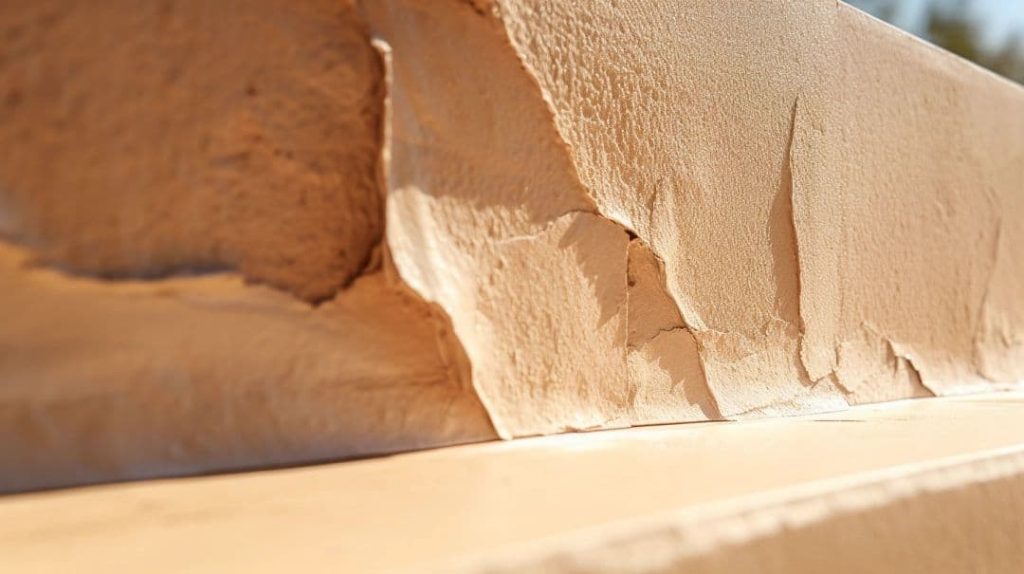
You now hold the keys to safeguarding your home‘s exterior insulation and finish system from water damage. Remember, prevention is always better than cure; ensure proper installation and regular maintenance of your EIFS.
Ask yourself, when was the last time you inspected your home for signs of wear? Taking action could prevent costly repairs in the future. Your EIFS cladding needs attention just like any other part of your house – don’t overlook it.
For those tougher challenges, seeking expert advice can make all the difference in successful repair or replacement decisions. Let this guide empower you to protect your investment with confidence and vigilance. To request your free EIFS estimate or get more details call (765) 341-6020.
FAQs
What are some common causes of water damage in EIFS systems?
Some common causes of water damage in EIFS systems include improper installation, construction defects, failed sealants, roof and flashing issues, mechanical damage, thermal bridging, age and wear, use of low-quality materials, and landscaping issues. Moisture intrusion can happen through gaps, cracks, or degraded materials over time.
What are signs I should look out for to detect water damage in my home’s EIFS?
Signs to look out for include cracking or splitting in the EIFS finish, bubbling or blistering, discolored patches, soft spots on walls, peeling paint, mold/mildew growth, swelling around windows and doors, and any suspicious musty odors indoors. Tapping to listen for hollow sounds can also help identify problem areas.
Should I completely remove my home’s EIFS system if I find water damage?
Not necessarily. For minor damaged areas, targeted repairs may suffice to restore integrity, which is a more cost-effective approach. However, for severe widespread damage, mold growth, or safety concerns like wall stability, full EIFS removal and replacement may become necessary. Consult a professional to assess damage levels.
What should I look for when hiring a contractor to repair my EIFS water damage?
When hiring a contractor, ensure they specialize in EIFS systems. Check they have experience accurately diagnosing damage and working with materials like sealants designed for EIFS. Verify they follow industry best practices, use high-quality materials, have proper licensing and insurance, and provide detailed project contracts. Reviews and references can also give insight into the quality of work.
How can I prevent water damage problems with my EIFS system in the future?
Prevention is key. Ensure proper initial installation per manufacturer specifications and building codes, use durable and water-resistant materials, maintain the recommended height above ground level, routinely inspect sealants and flashings for wear, promptly address any cracks or gaps, employ preventative coatings, and repair issues early before they escalate or lead to mold growth.

